Another successful space launch. The history of the project "VEGA" (Vettore Europeo di Generazione Avanzata)
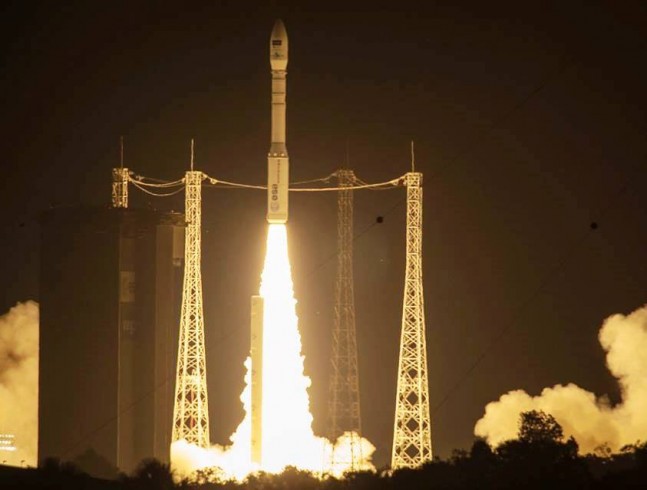
The more often Protons fall and the salaries of the builders of the Russian cosmodrome are delayed longer, the more active Mr. Komarov’s service is deploying, telling about the more ambitious projects of Roskosmos, which will be implemented
Under the cut I will tell in more detail about the most European space program
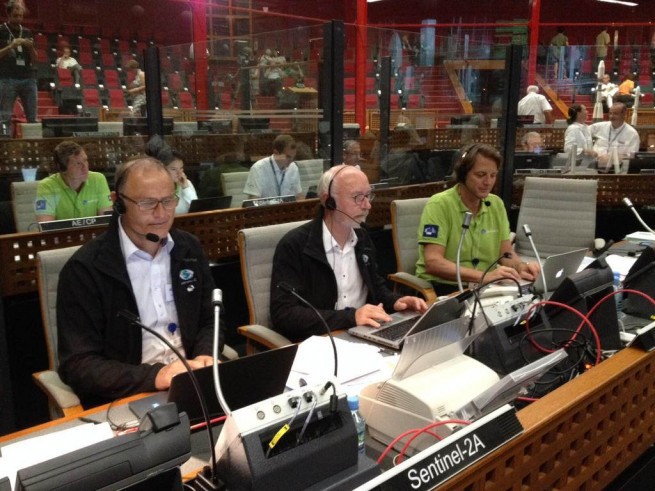
Strange as it may seem, the lead developer of the project is a country that is not too closely associated with space by a Russian - Italy. She also provided 65% of the budget, other participating countries - France (15%), Spain (6%), Belgium (5.63%), the Netherlands (3.5%), Switzerland (1.34%) and Sweden (0 ,eight %). There is no Russian contribution to this European project, but we can be glad for our closest neighbors in the former camp. At the top stage uses the marching AVUM RD-868P engine developed by the Ukrainian Yuzhnoye Design Bureau. M.K. Yangel and manufactured by the State Enterprise “Production Association„ Southern Machine-Building Plant named after A.M. Makarova "(Dnepropetrovsk).
')

First, a little about the satellites.
The launch goal of the satellite launched into orbit during the last launch, Sentinel-2A, is to monitor the state and changes in the Earth's surface. The device is able to observe the planet at intervals of minus 53 degrees to plus 83 degrees of latitude, which will allow you to get clear pictures of Europe.
The estimated lifetime of the satellite is 12 years and is limited by the fuel supply for the orbital maneuvers. The estimated service life of the device is estimated at 7.25 years. The Sentinel-2A Agreement for EUR 195 million for ESA and Airbus was signed in 2008. In 2009, the agreement on the second satellite (Sentinel-2B) was signed, which should be launched in 2016.
The ESA Sentinel program includes five groups of satellites: Sentinel-1 (for obtaining radar data from ERS and Envisat satellites), Sentinel-2 and Sentinel-3 (for monitoring the ocean and land), and also Sentinel-4 and Sentinel-5 ( for weather and climate studies of atmospheric composition).
Background of the birth of the project.
The Vega program begins a decade ago, when the changing balance of political forces in the world and a change in government priorities led to a drastic restructuring of the space industry in those countries where there was one.
First, former Soviet launch vehicles for various purposes, including the military, became available to the whole world overnight, and competition in the market grew fiercer. Secondly, the consolidation of the American aerospace industry, which was rapidly implemented under Clinton, significantly increased its competitiveness in the global market.
There have also been profound changes in the satellite market. On the one hand, the mass of vehicles intended for work in the geostationary orbit began to grow rapidly. On the other hand, interest in the deployment of large orbital groups deployed in low and medium orbits (the so-called LEO and MEO concepts, Low or Medium satellite constellation concepts), which opened up opportunities for providing users with global, round-the-clock services of a new level, has sharply increased. In addition, the share of launches of military-made orbiters has decreased, and, conversely, the need for launches to the near-polar orbits of satellites intended for remote sensing of the Earth has increased.
All of these factors led the ESA to develop a formal European strategy for carriers (European Strategy for the Launcher Sector). It is designed to ensure the solution of the basic tasks of ensuring for European countries independent (and commercially beneficial) access to space, taking into account the current pan-European strategic, economic, cultural and political interests. The document provides that Europe needs to:
- To increase the competitiveness of its carrier Ariane V in the global market by expanding the capabilities of the launch vehicle, expanding the range of tasks solved with its help, and optimizing production and operational processes. In this case, the main goal is to reduce the unit cost of putting the payload into orbit.
- To provide customers with a full range of services for the removal of payload into space, for which it is necessary to supplement the heavy Ariane V with carriers of the middle and light classes.
- Provide a technological base for the development of new systems that can ensure the competitiveness of the ESA in the long term (2015 - 2020).
- Ensure the preservation of high quality services and the level of customer service of the ESA.
- A significant increase in the need for placing relatively small devices into orbit set as a primary task the creation of an inexpensive and multipurpose carrier designed for launching various types of payloads weighing from 300 to 2500 kg into orbits.
Some details.
The proposal of the Italians, who have accumulated rich experience in the development and
use of solid fuel engines.
As a first stage, the P80 FW high-performance solid fuel engine of the FiatAvia concern is used. Its design used the latest technical solutions - in particular, the carbon fiber body, the production of which is carried out by the winding method (filament-wound technology, FW).
Also widely used are the newest composite materials, providing it with enhanced performance and low cost - it is assumed that it will be 25-30% lower than that of similar solid-fuel engines with metal bodies. In the future, the P80 FW will open the way for the development of engines for the promising European carrier rocket of the middle class, as well as the creation of a new generation of solid-fuel accelerators for the heavy Ariane V.
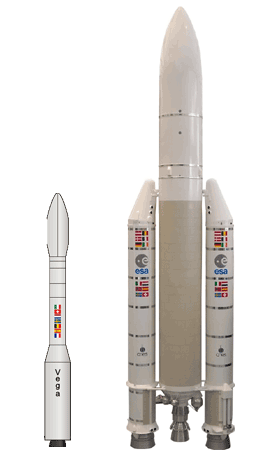
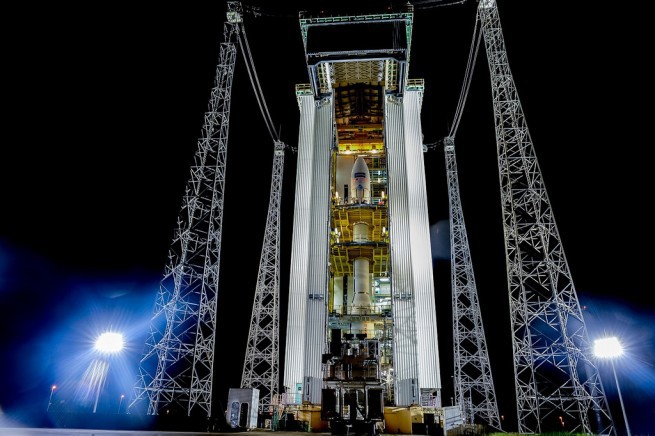
Right "Vega" is depicted against the backdrop of a heavy "Arian 5"
The second and third stages of Vega are also solid fuel engines Zefiro 23 and Zefiro 9. The fourth stage is the AVUM module (Attitude & Vernier Upper Module).
AVUM is intended for the final adjustment of the parameters of the transition orbit and its circularization (transfer of the payload to a circular orbit), issuing a braking impulse, controlling the rotation of the complex during the third stage and controlling the orientation along three axes on passive flight segments. The engine of the stage is liquid (nitrogen tetroxide + asymmetric dimethylhydrazine), the avionics unit is located above it.
The payload compartment consists of a standard payload adapter and a fairing (external diameter 2.6 m, total length 7.9 m, including the horizontal section 3.5 m). Reset the fairing is carried out on the passive part of the flight before turning on the engine of the third stage.
Due to the widespread use of new materials, Vega was relatively compact and light. With a length of 27 m and a maximum diameter of 3 m, its take-off weight is 128 tons.
The ELA-1 launch pad, originally intended for the Ariane-1 PH, and the Ariane-5 control center are supposed to be used to support the Vega launches from the Kourou cosmodrome.
Due to the successful location of the cosmodrome on the ocean coast near the equator, Vega launches can be carried out in a wide range of azimuths, including in the equatorial and meridional planes, as well as on orbits with intermediate inclinations.
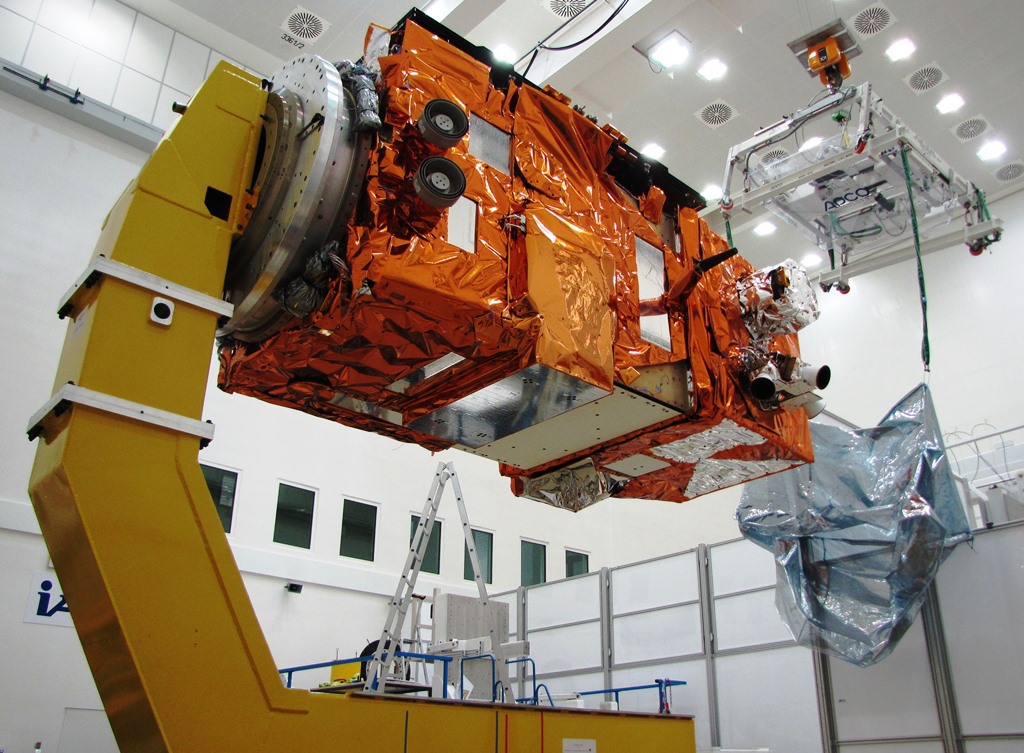
The photo shows the testing process.
History, prospects and competitors
It took 25 years of development, several delays and more than € 700 million for the European budget Vega to be finally ready for its first flight. It is the smallest of the three ESA carriers. The space agency hopes that the new rocket will be able to satisfy the market demands for launching small research satellites and will make space research accessible to university science. Vega will be used mainly for satellites monitoring the Earth’s surface.
The first five launches were paid by the European Space Agency, whose satellites were the main cargoes of the Vega launch vehicle. As part of this program, the following satellites went into space (and will be released): Sentinel-2, -3, Proba-V and Aeolus, as well as a scientific satellite to study gravity waves LISA-Pathfinder.

Competitors in the segment of light launch vehicles.
After 2016, the ESA will independently look for a payload on the market. The potential customers are national space agencies, universities and commercial companies. It is planned that Vega will carry out 3–5 missions per year, and the estimated launch cost will be 4–5 million US dollars. You will have to compete with Russian, American and Chinese projects.
For those who are interested in the topic and for whom spoken English is not a problem, I propose to watch a very interesting video report on this topic.
The main materials are drawn from news, as well as the following sources:
Wikipedia
http://www.spaceflightinsider.com
Thank you for attention.
Source: https://habr.com/ru/post/367507/
All Articles